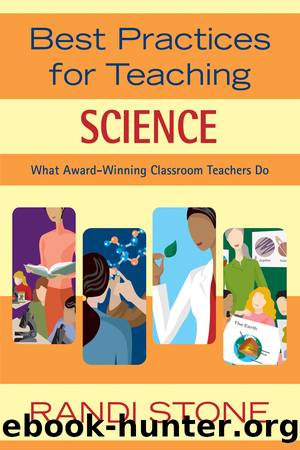Best Practices for Teaching Science by Randi Stone

Author:Randi Stone
Language: eng
Format: epub
Publisher: Skyhorse
Published: 2015-01-01T00:00:00+00:00
CHAPTER 11
Mission Possible
Pam Roller
Galveston, Indiana
It is my mission in life to give my students as many experiences as possible to stimulate and motivate them to want to learn. One of those experiences is what I call Mission Possible, and it is how I keep science alive in my class. I have had a space shuttle simulator in my classroom since 1996. It is 16 feet long, 8 feet high, and 8 feet wide. The mockup is a replica of the space shuttle, and it is fully equipped with computers, two-way cameras and radios, color TVs, and a VCR. I also have a mission control area in my classroom so the simulation can be as realistic as possible.
My second graders and their parents have had the opportunity to simulate missions in space through my School On Saturday Program. The program is offered to my second graders and their parents. It allows parents the opportunity to be engaged in a fun learning experience with their children. They actually suit up like astronauts and go through an actual launch, do orbital experiments, and end with a landing. The simulation is perfect for students to develop skills in problem solving and decision making and to learn the importance of cooperation and teamwork.
During the orbital part of the mission, my students have numerous opportunities to explore and make new discoveries as they conduct their own experiments growing plants and crystals. The students learn about responsibility and ownership when caring for their own plants. They have many opportunities to make observations, record data, infer, inquire, compare, and draw conclusions.
I recall one very memorable Mission Possible. It was during a School On Saturday Program with my second graders and their parents. This particular Saturday, the mother of one of my students was battling cancer and could not attend, so the studentâs grandmother, who has multiple sclerosis (MS) really badly, brought her to school so she could participate in Mission Possible. The grandmother could hardly get around but never complained. She had the best attitude and the most energy of anyone in attendance.
This grandmother suited up like everyone else and did all the experiments with enthusiasm beyond belief! After the mission, I told her what an inspiration she was! She said she decided to bring her granddaughter to simulate Mission Possible so she would be busy learning in a fun way and for a brief while she wouldnât be so worried about her mother. Not only are missions possible, anything is possible when you believe! The girlâs mother is free from cancer and the grandmother still has MS but is still going strong!
I have offered my Mission Possible space shuttle simulation to the students in my afterschool Young Astronauts Program and to 22 different schools in Indiana through a Kids College Program offered at Indiana University Kokomo (IUK) in Kokomo, Indiana. Mission Possible was the name of a class I taught for Purdue Universityâs summer institute for gifted students, which culminated with a field trip to my classroom to simulate a day mission.
Download
This site does not store any files on its server. We only index and link to content provided by other sites. Please contact the content providers to delete copyright contents if any and email us, we'll remove relevant links or contents immediately.
When The Scientist Presents: An Audio And Video Guide To Science Talks (With Dvd-rom) : An Audio and Video Guide to Science Talks by Jean-Luc Lebrun(145)
Defending Qualitative Research by Mario Cardano(126)
Best Practices for Teaching Science by Randi Stone(124)
A Question of Physics by Paul Buckley(123)
Engineering Mechanics 2: Mechanics of Materials by Dietmar Gross Werner Hauger Jörg Schröder Wolfgang Wall Javier Bonet(122)
Solving Everyday Problems with the Scientific Method by Thinking Like a Scientist(113)
Improving Research-Based Knowledge of College Promise Programs by Perna Laura W.;Smith Edward J.;(109)
Texts in Computer Science by Orit Hazzan(104)
What Successful Science Teachers Do by unknow(102)
A Math-Based Writing System for Engineers. Sentence Algebra & Document Algorithms by Brad Henderson(102)
STEM the Tide : Reforming Science, Technology, Engineering, and Math Education in America by David E. Drew(102)
Dinaric Perspectives on TIMSS 2019 : Teaching and Learning Mathematics and Science in South-Eastern Europe by Barbara Japelj Pavesić; Paulína Korsňáková; Sabine Meinck(99)
Support for Forensic Science Research: Improving the Scientific Role of the National Institute of Justice by Committee on Strengthening Forensic Science at the National Institute of Justice(97)
A Passion For Discovery (237 Pages) by Peter Freund(94)
Researching Sustainability by Franklin Alex;Blyton Paul;(89)
The Leading World's Most Innovative Universities by Abdulrahman Obaid AI-Youbi; Adnan Hamza Mohammad Zahed; Mahmoud Nadim Nahas; Ahmad Abousree Hegazy(86)
Awe in research: Igniting curiosity and connection by Sandra Skjaervoe(85)
Solving Everyday Problems with the Scientific Method (234 Pages) by Don K Mak Angela T Mak & Anthony B Mak(76)
On Ve-Degree and Ev-Degree Based Topological Properties of Silicon Carbide Si2C3-II[p, q] by Cai Zheng-Qun & Rauf Abdul & Ishtiaq Muhammad & Siddiqui Muhammad Kamran(69)
